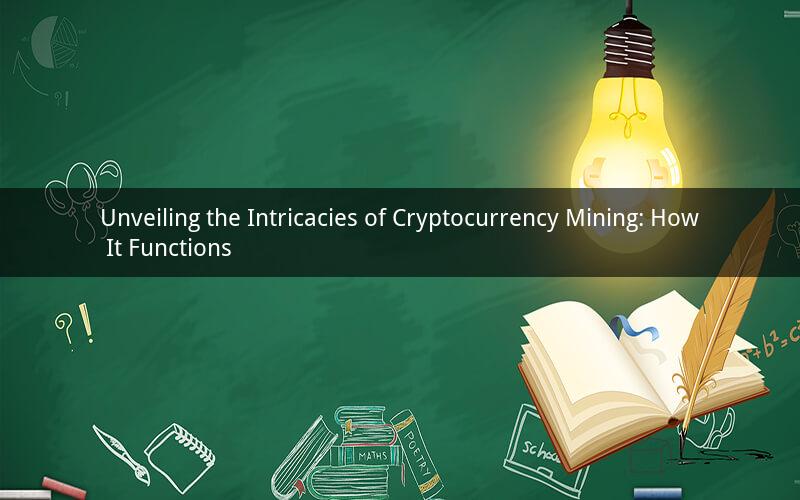
Cryptocurrency mining has emerged as a crucial aspect of the digital currency ecosystem. As the demand for cryptocurrencies continues to soar, understanding how mining operates is essential for both investors and enthusiasts. This article delves into the workings of cryptocurrency mining, exploring the underlying mechanisms and the role it plays in maintaining the integrity of the blockchain network.
1. What is Cryptocurrency Mining?
Cryptocurrency mining refers to the process of validating and adding new transactions to a blockchain network. Miners use powerful computers to solve complex mathematical problems, and in return, they are rewarded with cryptocurrency tokens. This process ensures the security and reliability of the blockchain, making it tamper-proof and decentralized.
2. The Blockchain Technology
The blockchain is a decentralized ledger that records all transactions in a chronological order. It is composed of blocks, each containing a set of transactions. Once a block is filled with transactions, it is added to the chain, creating a chain of blocks. The blockchain technology is designed to be transparent, secure, and immutable, making it an ideal platform for cryptocurrencies.
3. How Does Cryptocurrency Mining Work?
The process of cryptocurrency mining involves several steps:
a. Transaction Verification: When a user initiates a transaction, it is broadcasted to the network. Miners receive these transactions and verify them to ensure they are legitimate. This includes checking the sender's and receiver's addresses, the amount of cryptocurrency being transferred, and any attached data.
b. Block Assembly: Miners gather verified transactions and assemble them into a new block. This block contains a reference to the previous block, creating a chain of blocks. The block also includes a unique identifier called a nonce, which is used to solve the mathematical problem.
c. Proof of Work: Miners use their computers to solve a complex mathematical problem. This problem requires finding a number that, when hashed with the block's data, produces a result that meets certain criteria. The process of finding this number is known as proof of work. It is computationally intensive and requires significant processing power.
d. Block Validation: Once a miner solves the mathematical problem, they broadcast the solution to the network. Other nodes in the network verify the solution and, if valid, add the new block to the blockchain. The miner who solved the problem is rewarded with cryptocurrency tokens.
4. The Role of Mining Pools
Mining pools are groups of miners who collaborate to increase their chances of solving the mathematical problem and earning rewards. When a mining pool successfully mines a block, the rewards are distributed among the participants based on their contribution to the pool. Mining pools help reduce the risk of earning nothing, as the rewards are more predictable.
5. The Environmental Impact of Cryptocurrency Mining
Cryptocurrency mining has raised concerns about its environmental impact. The process requires a significant amount of electricity, leading to increased carbon emissions and energy consumption. However, the industry is continuously evolving, with some miners adopting more energy-efficient equipment and renewable energy sources.
6. The Future of Cryptocurrency Mining
As the demand for cryptocurrencies continues to grow, the future of mining looks promising. Advances in technology, such as more efficient mining equipment and the adoption of renewable energy sources, will likely make mining more sustainable. Additionally, the development of new consensus mechanisms, such as proof of stake, may reduce the environmental impact of mining.
Frequently Asked Questions (FAQs)
Q1: What is the primary purpose of cryptocurrency mining?
A1: The primary purpose of cryptocurrency mining is to validate and add new transactions to a blockchain network, ensuring its security and reliability.
Q2: How do miners verify transactions?
A2: Miners verify transactions by checking the sender's and receiver's addresses, the amount of cryptocurrency being transferred, and any attached data.
Q3: What is a mining pool, and how does it work?
A3: A mining pool is a group of miners who collaborate to increase their chances of mining a block. When a mining pool successfully mines a block, the rewards are distributed among the participants based on their contribution.
Q4: What are the environmental concerns associated with cryptocurrency mining?
A4: The environmental concerns associated with cryptocurrency mining include increased carbon emissions and energy consumption due to the high electricity demand of mining operations.
Q5: How might the future of cryptocurrency mining evolve?
A5: The future of cryptocurrency mining may evolve through the adoption of more energy-efficient equipment, the use of renewable energy sources, and the development of new consensus mechanisms like proof of stake.